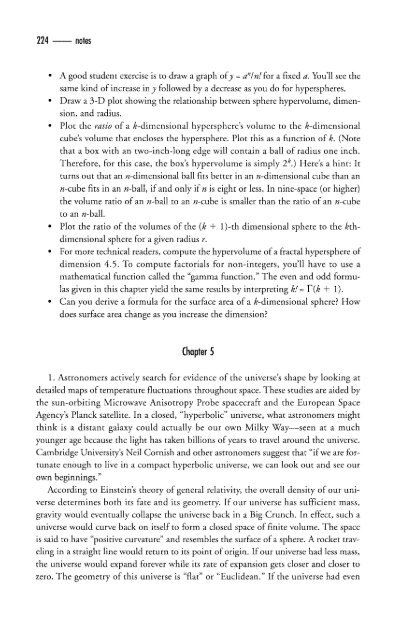clifford_a-_pickover_surfing_through_hyperspacebookfi-org
clifford_a-_pickover_surfing_through_hyperspacebookfi-org
clifford_a-_pickover_surfing_through_hyperspacebookfi-org
Create successful ePaper yourself
Turn your PDF publications into a flip-book with our unique Google optimized e-Paper software.
224 notes<br />
A good student exercise is to draw a graph of y = a"/n!for a fixed a. You'll see the<br />
same kind of increase in y followed by a decrease as you do for hyperspheres.<br />
Draw a 3-D plot showing the relationship between sphere hypervolume, dimension,<br />
and radius.<br />
Plot the ratio of a ^-dimensional hypersphere's volume to the ^-dimensional<br />
cube's volume that encloses the hypersphere. Plot this as a function of k. (Note<br />
that a box with an two-inch-long edge will contain a ball of radius one inch.<br />
Therefore, for this case, the box's hypervolume is simply 2*.) Here's a hint: It<br />
turns out that an w-dimensional ball fits better in an ra-dimensional cube than an<br />
w-cube fits in an w-ball, if and only if n is eight or less. In nine-space (or higher)<br />
the volume ratio of an w-ball to an w-cube is smaller than the ratio of an w-cube<br />
to an »-ball.<br />
Plot the ratio of the volumes of the (k + l)-th dimensional sphere to the £thdimensional<br />
sphere for a given radius r.<br />
For more technical readers, compute the hypervolume of a fractal hypersphere of<br />
dimension 4.5. To compute factorials for non-integers, you'll have to use a<br />
mathematical function called the "gamma function." The even and odd formulas<br />
given in this chapter yield the same results by interpreting k! = T(k +1).<br />
Can you derive a formula for the surface area of a ^-dimensional sphere? How<br />
does surface area change as you increase the dimension?<br />
Chapter 5<br />
I. Astronomers actively search for evidence of the universe's shape by looking at<br />
detailed maps of temperature fluctuations <strong>through</strong>out space. These studies are aided by<br />
the sun-orbiting Microwave Anisotropy Probe spacecraft and the European Space<br />
Agency's Planck satellite. In a closed, "hyperbolic" universe, what astronomers might<br />
think is a distant galaxy could actually be our own Milky Way—seen at a much<br />
younger age because the light has taken billions of years to travel around the universe.<br />
Cambridge University's Neil Cornish and other astronomers suggest that "if we are fortunate<br />
enough to live in a compact hyperbolic universe, we can look out and see our<br />
own beginnings."<br />
According to Einstein's theory of general relativity, the overall density of our universe<br />
determines both its fate and its geometry. If our universe has sufficient mass,<br />
gravity would eventually collapse the universe back in a Big Crunch. In effect, such a<br />
universe would curve back on itself to form a closed space of finite volume. The space<br />
is said to have "positive curvature" and resembles the surface of a sphere. A rocket traveling<br />
in a straight line would return to its point of origin. If our universe had less mass,<br />
the universe would expand forever while its rate of expansion gets closer and closer to<br />
zero. The geometry of this universe is "flat" or "Euclidean." If the universe had even







